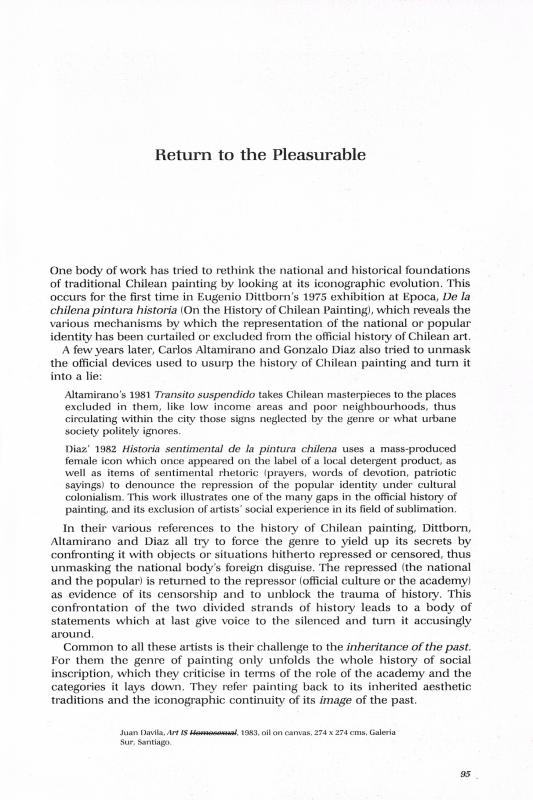Juan Domingo Dávila wrote this essay for Fábula de la pintura chilena (1983), the exhibition of his works at the Galería Sur in Santiago. There were two other contributors to the catalogue: the theorist and cultural critic Nelly Richard (b. 1948) submitted her essay “Cuerpo sin alma” [see (doc. no. 730158) in the ICAA Digital Archive] that refers to the idea that painting “lacks an inner life” and seeks to reveal the implications of quotes. The other contributor, the curator and art critic Justo Pastor Mellado (b. 1949), provided “La disputa de la cita bíblica” (doc. no. 730683), in which he reviews Dávila’s painting and compares it to the works of other artists who were part of the Escena de Avanzada.
After the coup d’état in Chile in 1973, Dávila moved to Australia and settled in Melbourne. But he kept in touch with the art community back home, mainly through his work with Nelly Richard. The book La cita amorosa (Love in Quotes, 1985) consisted of a theoretical-critical conversation between them (based on his work), in which Richard outlined a conceptual approach to a complex proposal that was destabilizing despite the fact that it still endorsed painting at a time when “dematerialized” experimental practices were all the rage in the Chilean art scene. Dávila’s work challenges painting with cultural quotes that can obliterate the concept of “author” by interweaving images taken from dissimilar sources that reveal their codes and the effects of their modus operandi. He populates his compositions with references from art history, comics, magazines, historical characters, and popular culture. He also uses obscenity and homosexuality for critical purposes, relying on an unconventional representation of human bodies to express his views on generic sex issues. [See, in the ICAA Digital Archive, the text by Dávila “La regresión de la situación cultural” (doc. no.731457).]
Juan Domingo Dávila was one of the artists that Richard included in her concept of Escena de Avanzada, an umbrella term she coined for neo-avant-garde practices that challenged art and the ways in which art was produced in a country under the rule of a civilian-military dictatorship (1973–90) where every aspect of social life had been dismantled. The "scene" involved the production of an unofficial kind of art designed to stimulate critical awareness and a resistance to the imposition of the government’s strategies for political repression. These art practices prioritized the use of language in an attempt to challenge the dominant cultural discourse. [On the subject of Richard’s views on painting in Margins and Institutions. Art in Chile since 1973 (1986), see “Return to the pleasurable” (doc. no. 743686); for other perspectives on Dávila’s work, see “Lástima que seas una rota” (doc. no. 731868) by Diamela Eltit and “Identidad y escatología” (doc. no. 738654) by Carlos Pérez Villalobos.]





